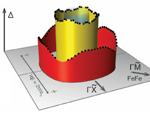Atomic-scale Visualization of Cooper Pairing in Iron Superconductors. Findings support magnetic pairing theory that could lead to new superconductors
In superconductors, electrons form Cooper pairs and move through the crystal lattice without resistance. By measuring how strongly Cooper pairs are bound together in an iron-based superconductor, scientists from Academia Sinica, the University of St Andrews, Cornell University, the U.S. Department of Energy’s (DOE) Brookhaven National Laboratory and AIST, Japan, provide direct evidence supporting theories in which magnetism holds the key to this material’s ability to carry current with no resistance. The measurements take into account the directions in which the electrons are traveling, which was central to testing the theoretical predictions, thereby strengthening confidence that this type of theory may one day be used to identify or design new materials with improved properties - namely, superconductors operating at room temperatures. The findings are published in Science 336, 563 on May 4, 2012.
High-temperature superconductors have been fascinating to both scientists and engineers since they could carry current with no loss at temperatures as high as 155 K (-110° Celsius – not far off from the lowest temperature recorded on earth with -90° Celsius). The hope is that understanding the physics of these compounds will lead to the design of superconductors able to operate at room temperatures, which can be used for energy-saving technologies, such as zero-lose power transmission lines. “In the best possible world you would be able to take this theory and plug in different chemical elements until you find a combination that should work as a superconductor at higher temperatures,” said team leader Prof. Séamus Davis of Cornell University and Brookhaven National Laboratory.
“The possibilities of such a technology are exciting. But trying to understand the fundamental electron-electron interactions within these materials is what motivates many of us” says Dr. Milan P. Allan, a lead author of this study. Indeed, the physics of high temperature superconductivity has confounded scientists over the last 30 years. It is generally believed that the magnetically mediated electron-electron interaction of these materials is the key. When iron-based superconductors were discovered in 2008, this idea received a big boost because their parent compounds exhibit similar magnetic properties as their copper-based counterparts. However, determining that role is a very complex problem. In each iron atom there are five magnetic electrons. In order to find out if the magnetic interactions between electrons are generating the superconductivity, one has to measure what’s called the anisotropic superconducting energy gap, which can tell scientists the bounding strength of Cooper pairs along different directions in momentum space.
Theorists Dung-Hai Lee of the University of California at Berkeley, Peter Hirschfeld of the University of Florida, Andrey Chubukov of the University of Wisconsin and others had developed different versions of a theory predicting what those measurements should be if magnetism were the pairing mechanism for the superconductivity. “It was often conjectured that spectroscopic imaging scanning tunneling microscopy would be an ideal tool to test some of these predictions. However, this method is still novel and we had to invent some of the crucial experimental tools ‘on the spot’. Pushing the SI-STM technique to new limits allowed us to gain the scientific results presented in this paper.” says Dr. Andreas W. Rost, the other lead author of the study.
Their method, multi-band Bogoliubov quasiparticle scattering interference, found the “signature” predicted by the theorists. "Although theorists predicted the existence of superconducting gap anisotropy, it’s difficult to calculate how large this effect is. Our measurements not only agree with the theoretical prediction but also provide theorists with crucial information towards a more quantified description." said Dr. Tien-Ming Chuang of Academia Sinica. The next step is to use the same technique to determine whether the theory holds true for other iron superconductors.
With team members from Academia Sinica (Taiwan), St Andrews (UK), Cornell (USA), Brookhaven National Laboratory (USA) and AIST (Japan), this is a truly international project. As team member Prof. Andy Mackenzie of St Andrews commented “With science becoming an increasingly global endeavor, we see this as a great example of international collaboration, bringing benefits to all parties and, crucially, driving advances in the field.”
If those experiments show that the theory is indeed correct, the model could then be used to predict the properties of other elements and combinations - and ideally point the way toward engineering new materials and higher-temperature superconductors.
This research was funded by the Academia Sinica Research Program on Nanoscience & Nanotechnology, the DOE Office of Science, the UK’s Engineering and Physical Sciences Research Council, the Japan Society for the Promotion of Science, the National Science Foundation, and a Royal Society Wolfson Research Merit Award.
The paper is available at http://dx.doi.org/10.1126/science.1218726

Journal Links: http://dx.doi.org/10.1126/science.1218726